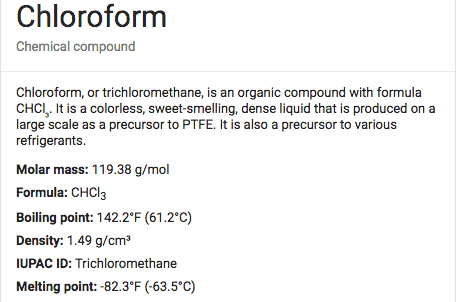How To Remove Chloroform From Water
About Chloroform:
What is Chloroform?
Also known as trichloromethane, chloroform is a colorless organic compound with a sweet odor. Chloroform is one of the four chloromethanes and is among the trihalomethanes group, also known as TTHMs. It is one of the most common disinfection byproducts found in drinking water. The dense liquid is famous for its ability to knock out or daze people.
What Types of Industrial Uses Does it Have?
The organic compound is essential for its industrial uses. Chloroform is used as a solvent for resins, gums, fats, and other organic compounds. It is essential as an anesthetic and reagent. Chloroform is also used in criminal activities since it is able to knock down people even in small amounts.
How Does Chloroform Get into Your Water?
Chloroform can enter water systems through improper waste management of chemical companies and paper mills. The adding of chlorine in drinking water will also result in chloroform contamination, as well as other TTHMs. These are byproducts of the chlorination process.
TTHMs in chlorinated water are very carefully monitored by treatment plants and waste water management, with the EPA having regulations and recommendations that are supposed to be implemented across the nation.
Why Do We Have Chlorinated Drinking Water?
The chlorination process has been incredibly beneficial to humanity by removing organic compounds and organic contaminants from water sources, greatly reducing illness caused by contaminated tap water. The unfortunate result of the chlorination process, however, is the byproducts in chlorinated tap water.
The process of chlorination of drinking water makes chloroform a common contaminant in the United States as well as in many countries around the world. In short, the solution to eliminate bacteria in water causes another water contaminant.
What are the Health Risks Associated with Chloroform and Chlorinated Water?
More than 220 million people in 46 states consume tap water with chloroform. Exposure to the disinfection byproduct in drinking water can cause liver, kidney, and central nervous system damages, pregnancy problems, and an increased risk of getting bladder cancer.
Can Chloroform Contamination Impact The Central Nervous System?
According to this toxicological review – “The main target organs of chloroform-induced toxicity are the central nervous system and the liver. The main symptoms of acute chloroform poisoning depend upon the concentration of chloroform absorbed, rather than the route of exposure”
While it is talking about heavy doses of chloroform, this shows us where and how chloroform contamination is damaging. Significant dermal exposure is also sited as dangerous, though not likely as dangerous as exposure through breathing in the gas phase version of chloroform – meaning it can be absorbed through skin.
This means that breathing steam from chlorine treated water and bathing in or showering in that water can cause significant exposure to the toxins. Skin contact actually comprises as significant amount of exposure in our modern world where bathing and hand washing are now everyday parts of life. Removing chloroform is becoming more and more important.
How Common is Chloroform in Water?
As a disinfection byproduct, chloroform is found in tap water. According to the EPA, chloroform is safe at levels found in tap water. The organic compound is among the several byproducts of chlorination of drinking water, and it is common in most public water systems.
Since most public water systems require water disinfection, there’s a high chance of finding the byproduct in tap water. Chloroform occurs in the water as one of the TTHM byproducts. Eliminating chloroform altogether is a very tricky process, and only the few communities that are able to use ground water without chlorination are free from the need to do so.
What is the EPA’s Contamination Level Standards for Chloroform in Drinking Water?
The EPA’s Safe Drinking Water Act initiative monitors 50,000 Community water systems – They use compliance monitoring, compliance assistance, and enforcement to try to improve all water sources for all Americans. However, at least 38% of American community water systems are outside of compliance.
The Environmental Protection Agency has set its maximum contaminant Level Goals (MCLG) to 0.07 mg/L or 70 ppb. The MCL for chloroform is at 0.080 mg/L or 80 ppb.
These levels are below what is proven to cause major health issues/risks, but we do not know how the lower levels are affecting the health of the population.
What is the Best Reduction Media for Removing Chloroform from Drinking Water?
Like other trihalomethanes, chloroform is best removed with high-quality granular activated carbon. The filtration media is found in many reliable water filtration systems. AquaOx’s filter systems are equipped with premium granular activated carbon (GAC) to remove chloroform and other contaminants to below the EPA’s contamination level standards. Get a water filter system today and shield your family from the harmful effects of chloroform in drinking water!
In the past, charcoal packed bed filters were the gold standard for removing chlorination by products, because the charcoal bed removes a significant amount of contamination. However, the newer carbon bed system is a more compact, more refined system.
From The Agency of Toxic Substances and Disease Registry
CAS ID #: 67-66-3
Affected Organ Systems: Cardiovascular (Heart and Blood Vessels), Developmental (effects during periods when organs are developing) , Hepatic (Liver), Neurological (Nervous System), Renal (Urinary System or Kidneys), Reproductive (Producing Children)
Cancer Classification: EPA: Probable human carcinogen. IARC: Possibly carcinogenic to humans. NTP: Reasonably anticipated to be a human carcinogen
Please contact NTP, IARC, or EPA’s IRIS Hotline with questions on cancer and cancer classification.
Chemical Classification: Volatile organic compounds
Summary: Chloroform is a colorless liquid with a pleasant, nonirritating odor and a slightly sweet taste. It will burn only when it reaches very high temperatures. In the past, chloroform was used as an inhaled anesthetic during surgery, but it isn’t used that way today. Today, chloroform is used to make other chemicals and can also be formed in small amounts when chlorine is added to water. Other names for chloroform are trichloromethane and methyl trichloride








